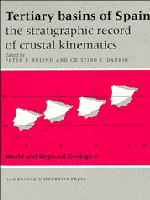Book contents
- Frontmatter
- Contents
- List of contributors
- Preface
- Dedication to Professor Oriol Riba IArderiu
- Memorial, Etienne Moissenet 1941–1994
- PART G GENERAL
- PART E EAST
- PART W WEST
- W1 The Duero Basin: a general overview
- W2 Alpine tectonic framework of south-western Duero basin
- W3 South-western Duero and Ciudad Rodrigo basins: infill and dissection of a Tertiary basin
- W4 Tectono-sedimentary evolution of the Almazán Basin, NE Spain
- W5 Tertiary basins and Alpine tectonics in the Cantabrian Mountains (NW Spain)
- W6 Lacustrine Neogene systems of the Duero Basin: evolution and controls
- W7 North-western Cainozoic record: present knowledge and the correlation problem
- W8 Onshore Cenozoic strike–slip basins in NW Spain
- W9 Tertiary of Central System basins
- PART C CENTRE
- PART S SOUTH
- Index
W1 - The Duero Basin: a general overview
Published online by Cambridge University Press: 04 August 2010
- Frontmatter
- Contents
- List of contributors
- Preface
- Dedication to Professor Oriol Riba IArderiu
- Memorial, Etienne Moissenet 1941–1994
- PART G GENERAL
- PART E EAST
- PART W WEST
- W1 The Duero Basin: a general overview
- W2 Alpine tectonic framework of south-western Duero basin
- W3 South-western Duero and Ciudad Rodrigo basins: infill and dissection of a Tertiary basin
- W4 Tectono-sedimentary evolution of the Almazán Basin, NE Spain
- W5 Tertiary basins and Alpine tectonics in the Cantabrian Mountains (NW Spain)
- W6 Lacustrine Neogene systems of the Duero Basin: evolution and controls
- W7 North-western Cainozoic record: present knowledge and the correlation problem
- W8 Onshore Cenozoic strike–slip basins in NW Spain
- W9 Tertiary of Central System basins
- PART C CENTRE
- PART S SOUTH
- Index
Summary
Abstract
The Duero basin occupies a large area in the north-west of the Iberian Peninsula. It has an approximately quadrangular shape, and three of its four corners are the sites of distinctive sub-basins that extend outwards from the main basin. The different margins of the sub-basins and the main basin tend to have distinctive histories of tectonic and sedimentary evolution.
Introduction
The Duero Basin is the largest Cenozoic basin in Spain with a surface area of almost 50000 km2. It occupies the major part of the north-west Iberian Peninsula. High-relief mountains composed of igneous and metamorphic rocks of Paleozoic age (mainly to the south and west) and siliciclastic and carbonate rocks of Mesozoic age (mainly to the east) bound the basin (Fig. 1). These borders formed during the Alpine Orogeny and played an important role in the geodynamic evolution of the basin.
The roughly quadrangular basin extends into three relatively narrow basins protruding near the corners (Fig. 1).
– The Ciudad Rodrigo Basin, in the south-western corner, is a half-graben oriented NE–SW that penetrates south-westerly into the Hercynic Massif. Its sedimentary record consists mainly of Paleogene deposits, although no Early Paleogene deposits have been found so far.
– The Almazán Basin is a complex area that extends to the east between the Iberian Range and the Central System. It was filled by siliciclastic and carbonate sediments, along with some rare evaporites, of Paleogene and Neogene age.
[…]
- Type
- Chapter
- Information
- Tertiary Basins of SpainThe Stratigraphic Record of Crustal Kinematics, pp. 183 - 187Publisher: Cambridge University PressPrint publication year: 1996
- 14
- Cited by



